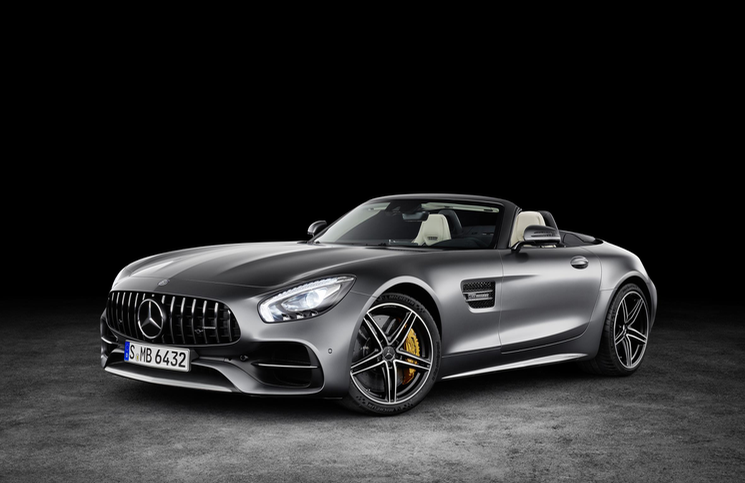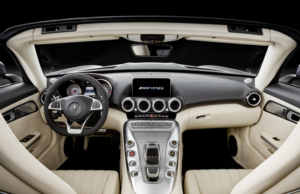 More hotly anticipated details have been released concerning both the new Mercedes-AMG GT Roadster and Mercedes-AMG GT C Roadster. Not long after the world premiere of the hardcore GT R, the AMG branch have significantly bolstered out their performance car portfolio with these two new models. The GT Roadster is mostly much what you would expect, the GT coupe with its roof chopped off, but the all-new GT C Roadster offers and all new variant to the supercar lineup.
More hotly anticipated details have been released concerning both the new Mercedes-AMG GT Roadster and Mercedes-AMG GT C Roadster. Not long after the world premiere of the hardcore GT R, the AMG branch have significantly bolstered out their performance car portfolio with these two new models. The GT Roadster is mostly much what you would expect, the GT coupe with its roof chopped off, but the all-new GT C Roadster offers and all new variant to the supercar lineup.
“With our two Roadster models, we are strategically expanding the AMG GT family by two exciting variants. With the AMG GT C Roadster, we are also introducing a new model variant to which have transferred main performance related components from our top sports car, the AMG GT R.” Says Tobias Moers, Chairman of Mercedes-AMG.
 Despite the lack of roof, both cars retain what is loved in the now five-strong AMG GT line-up, most poignant of all being that 4.0-litre twin-turbo ‘hot V’ engine. The standard GT Roadster produces 469bhp, but the GT C Roadster offers a whole new power output to the range, with 547bhp on tap. This means the GT C will sit between the GT S and GT R in terms of performance.
Despite the lack of roof, both cars retain what is loved in the now five-strong AMG GT line-up, most poignant of all being that 4.0-litre twin-turbo ‘hot V’ engine. The standard GT Roadster produces 469bhp, but the GT C Roadster offers a whole new power output to the range, with 547bhp on tap. This means the GT C will sit between the GT S and GT R in terms of performance.
All the rest of the technical specifications of both cars are as follows. The GT Roadster and GT C Roadster produce 630Nm and 680 Nm of torque respectively. Power is then sent to the rear wheels via the AMG Speedshift DCT 7-speed dual-clutch transmission in both cars. Despite the GT C Roadster weighing more – 1660kg in comparison to the GT Roadster’s weight of 1595kg, the GT C still has a superior power to weight ratio with 2.98kg/hp opposed to the GT’s 3.35kg/hp. This means 0-62mph in the GT C Roadster is dealt with in 3.7 seconds meanwhile the GT Roadster will hit the same target in 4.0 seconds. Following the onslaught of acceleration, the GT C will max out at a top speed of 196mph in comparison to the standard roadster’s top speed of 188mph.
The Mercedes-AMG GT C Roadster reaps the benefits of a electronically controlled limited slip differential instead of the GT Roadster’s mechanical system. To further set the GT C away from the GT, the GT C boasts AMG Ride Control sport suspension with adaptive adjustable damping – the GT uses standard AMG sport suspension. You can also expect the GT C to have greater  stopping power thanks to front and rear disc sizes of 390mm and 360mm respectively, whereas the GT uses 360mm discs at both ends. The differentiation of racing intent between the two cars is confirmed with the transmission modes available in each car – both cars get Comfort, Sport, Sport+ and Individual, but where that is all for the GT, the GT C also has a RACE transmission option.
stopping power thanks to front and rear disc sizes of 390mm and 360mm respectively, whereas the GT uses 360mm discs at both ends. The differentiation of racing intent between the two cars is confirmed with the transmission modes available in each car – both cars get Comfort, Sport, Sport+ and Individual, but where that is all for the GT, the GT C also has a RACE transmission option.
As well as many of these technical details being lifted from the GT R to the GT C, the GT C also takes the muscular rear end, large wheels, a wider rear track and active rear axle steering from the most hardcore AMG GT.
Both cars can go from coupe to roadster in eleven seconds using the automatic fabric roof at speed of up to 31mph. There are three fabric colour option for the roof: black, red and beige which can be chosen to suit the choices of eleven exterior and ten interior colours. The soft top is help up by a low weight magnesium, steel and aluminium structure to keep weight down and lower the centre of gravity.
Both the AMG GT AND GT C adopt a technical highlight from the R: the active air management system. Vertical louvres found in the lower area behind the front fascia are automatically opened and closed within a second to ensure optimal cooling performance. During normal driving the louvres are closed to reduce drag and improve efficiency but are opened when specific components reach a certain temperature.
Pricing is yet to be confirmed but AMG officials have suggested a £10,000 premium will be placed on the roadster models. The means the GT Roadster will cost around £107,000 whereas the Mercedes-AMG GT C Roadster will likely set buyers back around £120,000. Deliveries are expected to begin around April 2017.











